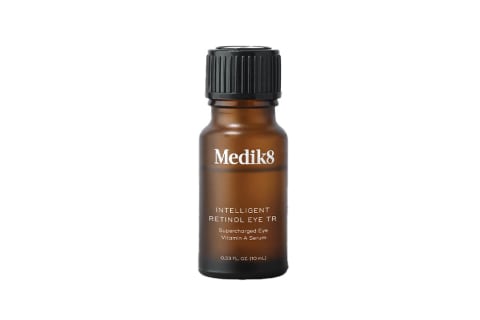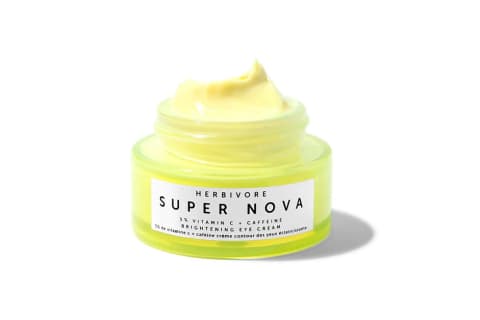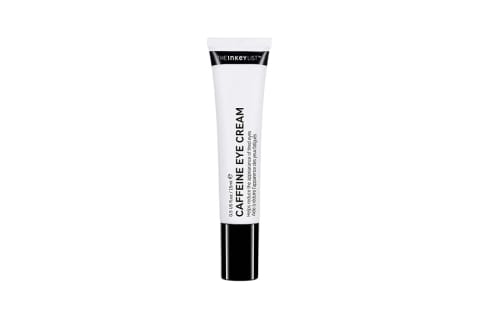How To Get Rid Of Under-Eye Wrinkles + Common Causes


Some wrinkles are brought on by age alone, and there's nothing wrong with displaying a long and joyful life on your face. Still, it's normal to wonder why some areas of the face have more fine lines than others. Or why they seem to appear more readily. One such area is the under eyes.
And it's important to learn about wrinkle formation because some wrinkles can be a sign that your skin is craving more care—be it moisture, a break from certain ingredients, etc.
To find out what your under-eye wrinkles are telling you, keep reading.
Cause of under-eye wrinkles.
To follow, a few potential triggers for under-eye wrinkles. After this, we'll talk treatments.
- UV exposure: "UV exposure plays a huge role in under-eye wrinkle formation," board-certified dermatologist Lauren Penzi, M.D., FAAD, tells mbg. "Over time, UV exposure leads to the breakdown of collagen and elastin, which significantly contributes to the formation of wrinkles," she adds. If your under-eye wrinkles are paired with dark spots on the face as well, then sun damage might be your main concern.
- Movement: Next, we have expression wrinkles, formally called dynamic wrinkles. Anyone can have them, no matter their age and they're not a sign of any negative skin-related habits. If anything, these expression wrinkles mean you're smiling often, which, if anything, is good for your skin. Not sure if your wrinkles are expression lines? Look in the mirror and make a few different faces—smile, frown, squint your eyes, etc. If the fine lines match, then you've got dynamic wrinkles.
- Free radicals: Next up, we have free radicals. These molecules are created as normal byproducts of cell metabolism or by exposure to external sources like X-rays, air pollution, cigarette smoking, and pesticides. When free radicals come in contact with the skin, they put it into a state of oxidative stress. When this state is prolonged, it actually speeds up the skin aging process1 and triggers dark spots and other discoloration.
- Sleep position: "Sleep position can definitely contribute to under-eye wrinkles," Penzi says. When you sleep on your side or stomach, you can easily tug on the delicate under-eye area. "This repeated force over time stretches the skin and expedites the appearance of wrinkles," she notes. Changing how you sleep isn't an easy feat, but it's certainly worth a shot if you suspect your skin is suffering. If that doesn't work, consider adding a silk or satin pillowcase for a tug-free snooze.
- Lifestyle habits: As with any skin concern, diet and exercise certainly play a role in under-eye wrinkles. "Diet is definitely important for our skin overall and likely plays a role in under-eye wrinkle formation," Penzi says.
- Harsh topicals: Finally, we have harsh topicals. Some ingredients like chemical exfoliants and potent retinol formulas can irritate the delicate under-eye area, resulting in fine lines over time. Even if you don't put these products directly on the under-eyes, they can easily spread from the rest of your face to this area—a quick hack to prevent that in a bit.
Solutions for under-eye wrinkles.
Now that you have a general idea of what might be causing your under-eye wrinkles, let's get into the best ingredients to look for in your eye creams and serums. Plus, some lifestyle habits to keep in mind:
Retinol
"Retinol is a great choice for wrinkle prevention, as it works to build new collagen," Penzi shares. However, we're talking about gentle retinol that's found in under-eye creams, not face retinol serums.
"It is safe to use in this area if it is formulated using a low concentration, a gentle cream type base, and compounded with other nourishing or hydrating ingredients like ceramides, hyaluronic acid, etc.," she adds.
While this ingredient is highly effective, it's also highly irritating for those with sensitive skin, Penzi notes. So if you typically struggle to tolerate retinol serums at all, be cautious about using it in your under-eye care and opt for one of the next ingredients instead.
Antioxidants
As mentioned above, oxidative stress can lead to a host of skin concerns including under-eye wrinkles. To protect this delicate area from free radicals, make sure you have antioxidants like vitamin C in your under-eye cream or serum.
Some may be able to tolerate vitamin C serums formulated for the face on this area, but they may cause irritation for others. Similar to retinol, the vitamin C found in eye creams will be less potent and mixed with more nourishing ingredients to buffer any irritation, so opt for the latter if you're prone to reaction.
Hyaluronic acid
Hyaluronic acid is a popular skin hydrator for a reason—it pulls water into the skin delivering a glowy, plump result. Because of this function, HA makes a great addition to any eye cream or serum and is found in plenty of products as is.
When used alone, hyaluronic acid will plump the under-eye area temporarily. This is great for makeup prep or a quick fix if your under-eyes are looking particularly droopy one day, but it won't have a lasting effect like retinol and antioxidants.
Pro tip: "I recommend applying HA prior to your under-eye cream or moisturizer to help maximize their benefits," Penzi says.
Peptides
Next up are peptides—more specifically, hexapeptides. As board-certified dermatologist Hadley King, M.D., previously told mbg, hexapeptides "can produce a mild, Botox-like effect, inhibiting the release of neurotransmitters that keep facial muscles from forming wrinkles2."
One specific hexapeptide known as Argireline or acetyl hexapeptide-3 can help diminish the creasing that causes fine lines, King said. Not to mention, peptides also help smooth texture and strengthen the skin barrier—a win-win for the delicate under-eyes.
Eye patches
As face masks are great tools for a quick skin overhaul, eye patches offer a similar benefit. This is great for those who need some instant gratification be it to prep for a big event or just have brighter, plumper under-eyes every once in a while.
These eye masks often include similar ingredients as eye creams, but they work in a slightly different way.
"Under-eye masks are unique because they actually provide a layer of protection to seal in the ingredients they are delivering," board-certified dermatologist Kim Nichols, M.D., founder of NicholsMD of Greenwich, told mbg.
Not sure which ones to choose? Luckily, we compiled a list of the best under-eye patches on the market right now for you to shop—scan our list here.
Aloe vera
Want to take the DIY route? Look for fresh aloe vera next time you're at the supermarket. This ingredient will deeply hydrate the under-eyes (like its humectant cousin hyaluronic acid) but also helps to brighten dark circles.
In fact, one study found that the topical application of aloesin can directly inhibit hyperpigmented skin.
You can use fresh aloe as an under-eye mask (or apply it to the whole face) or you can freeze it as an aloe vera ice pop and roll it under your eyes in the morning for some depuffing power and a relaxing massage.
Caffeine
"Caffeine is a popular choice in under-eye treatments these days, and for good reason," says Penzi.
"It is a vasoconstrictor, meaning it constricts blood vessels. This leads to a tightening effect when applied to the under-eyes," she adds. Not to mention, caffeine is also an antioxidant, so it checks two boxes at once.
SPF
We know, putting sunscreen under your eyes doesn't sound like the most enjoyable experience, but it's essential. "In addition to protecting the skin of your face with SPF, it is important not to forget the eyelid skin and other sensitive areas," double board-certified dermatologist Brendan Camp, M.D., said—under-eyes, lips, and scalp included.
Some eye creams do contain SPF, but if they don't, your typical face sunscreen will do. Just be sure to strategically apply the lotion, avoiding the orbs themselves to mitigate any stinging or irritation.
Prioritize a nutrient-dense diet.
Penzi specifically notes vitamin C as an important nutrient to prioritize for skin health. "Vitamin C (found in citrus fruits, peppers, strawberries, etc.) is an essential cofactor for collagen synthesis and protection against reactive oxygen species," she says.
If you're not positive you're getting enough vitamin C in your diet, try adding a supplement to your routine—here's a list of the best ones to consider, all approved by a nutrition Ph.D.
Don't skip regular exercise.
Last but not least is exercise. "Exercise improves circulation to all organs, including our largest organ, which is our skin," says Penzi. "Improved circulation means better delivery of oxygen and nutrients to our skin cells and improved clearance of toxins, free radicals, etc.," she adds.
There's not a single best type of exercise out there. The important thing is to find a way to move your body that sparks joy so you're more likely to stick with it.
When to see a dermatologist.
If you purchase a new eye cream, commit to using the whole thing before giving up—major changes in the skin take some time! But if your under-eye wrinkles are making you feel insecure and taking up mental space, you can visit a dermatologist for in-office solutions like microneedling and radio-frequency.
As you may already know, under-eye filler is another in-office solution for those with severe dark circles or under-eye wrinkles. Should you choose to take this route, just be sure to ask your dermatologist about the risks and benefits of this procedure before committing, as the under-eye region can be a particularly challenging spot to place filler.
"The major risks are bruising and swelling, with less common risks including infection or nodule formation. If the filler is inadvertently injected into one of the blood vessels, it can cause necrosis (death) of the overlying skin or can cause occlusion of the blood vessels leading to the eye and result in blindness," said board-certified dermatologist Brian Hibler, M.D.
"Therefore, it is important to see a board-certified dermatologist with appropriate training in safely performing these procedures," he added.
Prevention tips.
Many of the treatment options listed above will simultaneously prevent the wrinkles from getting worse or forming new ones. But, as a quick reminder, here are a few ways to encourage tighter, fuller under-eyes in the future:
- Don't skip SPF: As we mentioned above, keep SPF under your eyes at all times.
- Be consistent with your skin care: No matter how powerful your under-eye cream is, it won't reach its full potential unless you use it daily (or as directed), so stay committed.
- Block irritating ingredients: Remember when we mentioned how retinol and exfoliants can irritate this delicate area? To prevent this from happening, apply a barrier cream to this area before you apply your actives all over your face.
- Keep the skin hydrated: Nothing will make wrinkles look more prevalent than dry skin, so keep the under-eyes (and face in general) hydrated throughout the day. If this means carrying a hydrating cream in your purse, so be it.
PSA: Under-eye wrinkles are normal.
As a gentle reminder before we wrap up, don't be too hard on yourself about wrinkles under the eyes, because they're completely normal.
Look at children and babies—when they smile, they technically have "crow's feet" too. If you've gotten into the head space of assuming your eyes should never move or all of your wrinkles are caused by something negative, remember that.
Once those wrinkles settle in, you can certainly call upon the ingredients and tactics above to encourage plumper skin, but all in all, eye wrinkles are a sign you're living your life and expressing joy—which is something to be proud of, if anything.
Under eye wrinkle products
FAQ
Can wrinkles under eyes go away?
Some wrinkles under the eyes can go away with the use of under-eye creams and serums. Look for ingredients like retinol, peptides, hyaluronic acid, vitamin C, and caffeine. In-office treatments like microneedling and radiofrequency may help as well.
Why are my under-eyes so wrinkly?
Under-eye wrinkles can be linked to aging skin, UV exposure, free radical damage, sleep positions, lifestyle habits, and the use of harsh or irritating ingredients on the under-eyes.
How can I get rid of under eye wrinkles at home?
If you want to ease your under-eye wrinkles without in-office treatment, invest in an eye cream or eye serum. Ingredients like peptides, hyaluronic acid, caffeine, retinol, and vitamin C can be helpful. In addition, make sure your sleep position is not contributing to your under-eye wrinkles.
The takeaway.
There's no reason to be ashamed of under-eye wrinkles brought on by emotional expression and age. However, these wrinkles can sometimes be a sign that your skin needs more topical support, so add an eye cream to your routine, prioritize healthy lifestyle habits, and visit a dermatologist if you're struggling to ease these wrinkles. Want more topical options? Shop our curated list of the 14 best natural and organic eye creams here.

Hannah Frye is the Assistant Beauty & Health Editor at mindbodygreen. She has a B.S. in journalism and a minor in women’s, gender, and queer studies from California Polytechnic State University, San Luis Obispo. Hannah has written across lifestyle sections including skin care, women’s health, mental health, sustainability, social media trends, and more. She previously interned for Almost 30, a top-rated health and wellness podcast. In her current role, Hannah reports on the latest beauty trends and innovations, women’s health research, brain health news, and plenty more.


